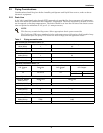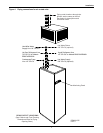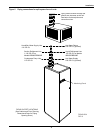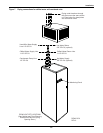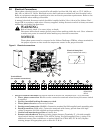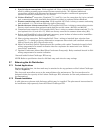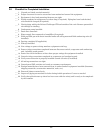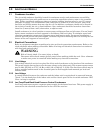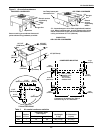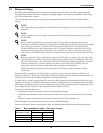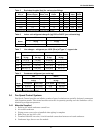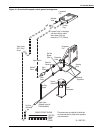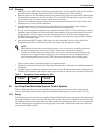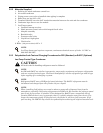
Air-Cooled Models
14
3.0 AIR-COOLED MODELS
3.1 Condenser Location
The air-cooled condenser should be located for maximum security and maintenance accessibility.
Avoid ground level sites with public access or areas that contribute to heavy snow or ice accumula-
tions. Utilize centrifugal condensers whenever interior building locations must by used. To assure
adequate air supply, it is recommended that condensers be located in a clean air area, away from
loose dirt and foreign matter that may clog the coil. In addition, condensers should not be located in
the vicinity of steam, hot air, or fume exhausts. Also, condensers should be located no closer than
three feet (1 meter) from a wall, obstruction, or adjacent unit.
Install condensers in a level position to assure proper refrigerant flow and oil return. For roof instal-
lation, mount condensers on steel supports in accordance with local codes. To minimize sound and
vibration transmission, mount steel supports across load bearing walls. For ground installation, a
concrete pad will provide adequate support. Condenser legs have mounting holes for securing the con-
denser to the steel supports or concrete pad.
3.2 Electrical Connections
Refer to equipment nameplate regarding wire size and circuit protection requirements. Refer to elec-
trical schematic when making connections. Make all wiring and electrical connection in accordance
with local and national codes.
3.2.1 Line Voltage
Line voltage electrical service is required for all air-cooled condensers at the location of the condenser.
This power supply does not have to be the same voltage as the indoor unit. This separate power source
may be 208, 230, 460, or 575 V, 60 Hz; or 200, 230, or 380/415 V, 50 Hz. The disconnect switch may be
factory-supplied and mounted in the electrical panel or field-supplied and mounted per local and
national codes.
3.2.2 Low Voltage
A control interlock between the condenser and the indoor unit is required and is connected between
70 and 71 in the handy box of the indoor unit and the electric panel of the air-cooled condenser. NEC
Class 1 wiring is required.
3.2.3 Lee-Temp/Flood Back Head Pressure Control Condensers
Lee-Temp condensers require a separate power supply for the heated receivers. This power supply is
connected to the electrical connection box on the end of the receiver.
!
WARNING
Risk of electric shock. Can cause injury or death.
Disconnect all local and remote electric power before working within the unit. Use a voltmeter
to make sure power is turned off before making any electrical connections.



